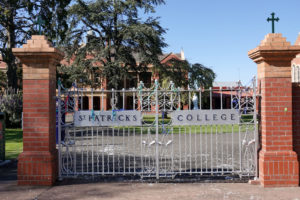Important information for 2020 General Achievement Test – October 7
September 30, 2020
The following should be read now in case there is something students should do this week to make the GAT go smoothly next week.
Who needs to do the GAT?
- Students doing a Scored VCE Unit 3/4 Study (includes some 2nd Year VCE/VET courses such as Engineering, Sport and Rec but not Building and Construction.)
 How do students enter the College on this day?
How do students enter the College on this day?
- Entry to the College is to be via the pedestrian gate on Sturt Street. Other gates will be locked. Students are to proceed directly to the Spring Boardroom – enter from near the College Chapel for temperature checking. Students are not to access any other part of the College until they have a stamp validating that their temperature is not elevated (above 37.5). After they have passed the temperature check, they will have access to locker areas. If running late they will still need their temperature checked before being granted entry to the GAT.
What time should students arrive?
- Students are encouraged to arrive by 9am to allow temperature checks to be completed for each student before they are allowed access to the greater part of the school. Temperature checks will commence at 8:30am. (Writing time commences at 10am)
What time will they be finished?
- Writing time is scheduled to finish at 1:15pm. Students can expect to have been dismissed after all papers have been collected by 1:30pm. At St Patricks College, students are not permitted to leave external exams before the end of writing time.
Is school uniform required on this day?
- Unlike in other years, school uniform is not required on this day. This is to enable students to dress warmly enough for the Br W.T. O’Malley Sports Centre which has no heating, or the OCA Pavilion with some doors open to allow for extra ventilation.
Are face masks required?
- Yes. Masks must be worn at all times. They are to be worn correctly, i.e. covering the mouth and nose.
Is Social Distancing required?
- Yes. Students are required to maintain a distance of 1.5metres from one another before, during and after the GAT.
 What equipment is allowed in the GAT?
What equipment is allowed in the GAT?
For a full list of rules and permitted materials and rules refer to the VCAA Exam navigator
- Blue or black pens for the writing task (suggest at least 3)
- Pencils (HB or 2B) (suggest at least 3)
- Highlighters
- Erasers/ pencil sharpeners
- Pencil cases must be clear plastic (suggest a large zip-lock sandwich bag)
- An English and/or bilingual printed dictionary – sort this out before the day – (A writing task prompt may have a word for which you do not know the meaning). A thesaurus or combined dictionary/thesaurus is not permitted.
- A clear plastic water bottle with no writing (label removed). Up to 1250 mL officially, but we recommend keeping it to 600mL as otherwise you lose writing time to toilet breaks.
What common items are not permitted in the GAT and should be left locked in lockers or at student reception?
- Mobile phones, smart watches, watches with a stopwatch function, fitness trackers, iPods, air pods, calculators and other electronic devices.
Do I need to know where I am seated before I go into the GAT?
- Yes, knowing which room (Pavilion or Gym) and which column and approximately which row is necessary for you to be seated before reading time commences. Your table will have a card with your name and VCAA number.
How will I know where I am seated?
- Mr Biggin (VCE Coordinator) will email the seating plans prior to the GAT. These will be in VCAA number order (without names). By doing a “find” for your VCAA number you will be able to see which room, column and row you are seated in. Write this down. The seating plan can be found at this link.
What if I don’t know my VCAA number?
- It will be on any printout you have received from VASS/VCAA, e.g. full details report of your VCAA enrolment or a statement of 2019 results. You can also obtain it be emailing adminsupport@stpats.vic.edu.au Privacy laws prevent us from printing a list of names alongside VCAA numbers. You will not need your number once seated at your table, but it is useful to bring with you on the day to help you find your table.
What happens if a student is too sick to do the GAT on October 7?
- There is no provision to derive a score for the GAT or to do it at a later date. However, students should obtain a medical certificate and provide this to the school so that we are able to apply for an “exemption” for them. This may become important should something happen that compromises their ability to perform at their best in the external exams.
- Let the school know you are sick
- If a student is well but a close contact of somebody who has tested positive to COVID-19, or if they themselves have tested positive to COVID-19, or if they are awaiting the outcome of a COVID-19 test, or if they have COVID-19 symptoms, they are to remain at home and let the school know (and access a COVID-19 test/access medical advice if in the last category). They will be eligible to apply for an exemption from the GAT. You may need a certificate from a medical practitioner recommending a COVID-19 test.
- If a student presents to the College with COVID-19 symptoms they will be isolated and their parents will be called to collect them. They will not be permitted to sit the GAT. These students will be eligible to apply for an exemption from the GAT.
Symptoms that DHHS have published to look for are:
- Loss or change in sense of smell or taste
- Fever, chills or sweats
- Cough
- Sore throat
- Shortness of breath
- Runny nose
- In certain circumstances headache, muscle soreness, stuffy nose, nausea, vomiting and diarrhoea may also be considered as symptoms of COVID-19.
- Should a student be a long-term sufferer of hay fever, they are encouraged to get a medical certificate from a medical practitioner stating that this is the case. This may then be used by staff when ascertaining whether their symptoms are likely to be hay fever related or COVID-19 related. Their medical practitioner may also provide advice regarding medications they may be able to take to lessen the severity of the symptoms
